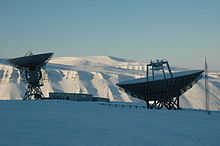European Incoherent Scatter Scientific Association
The European Incoherent Scatter Scientific Association ( EISCAT for short , German for "European Association for Research with Incoherent Scatter Radar") is a non-profit international research organization for conducting research on the atmosphere using incoherent scatter radar . It operates appropriate research facilities and makes them available to scientists for their research.
structure
The organization, based in Kiruna , Sweden, is supported by research organizations from many countries: the China Research Institute of Radiowave Propagation (CRIRP), the Academy of Finland (SA), the German Research Foundation (DFG), the National Institute of Polar Research ( NIPR, Japan), the Solar-Terrestrial Environment Laboratory of Nagoya University (STEL, Japan), Norway's Research Council (NFR), the Swedish Science Council (VR, Sweden) and the Science and Technology Facilities Council (SFC, United Kingdom). A fixed quota of usage time is available free of charge for participating organizations, depending on the participation share. It is also possible to purchase usage time for a fee or, on request, to allocate free usage time for a submitted project by an expert committee. Scientists from countries such as France, Russia and the Ukraine are also researching the facilities with the paid usage time.
The management is based on a council to which the individual member organizations send up to three members. This appoints a director who is responsible for the day-to-day operation and implementation of the Council's decisions.
history
The original proposal to establish EISCAT came from France. After the prospects were in the meantime unclear, it was finally founded on the mediation of Granville Beynon in 1975 and also supported by the initially negative British Science Research Council (SRC). While initially only the physical mechanisms behind the northern lights were in focus, after a few years the focus was more general on the interactions between the sun and earth and the nature and processes in the middle atmosphere. From 1990 to 92 another radar station was planned on Svalbard and built from 1993 to 1998. It started operations in 1996. In the same year, Japan also joined EISCAT. From 1999 to 2001 the existing systems were also brought up to the technical standard of the new ESR. The People's Republic of China joined in 2005 or 2007. The French CNRS and the German MPG were also involved until the end of 2006 . From 2005, a concept study for the successor infrastructure ("EISCAT_3D") was developed, which is to be built from 2015. The concept was adopted in 2008 by the European Strategy Forum for Research Infrastructures as part of the “European Roadmap for Research Infrastructures”.
The scientist Lassi Päivärinta ( IM Larsen), who is still active in the EISCAT program today, gave information about EISCAT to Stasi employee Thomas Runst ("IM Rudolf"), today Professor at the Friedrich Schiller University Jena , after research by the RBB in the 1980s , further.
Facilities
It operates several research radars north of the Arctic Circle in Kiruna , in and near Tromsø , in Sodankylä and in Longyearbyen on Spitsbergen . The purpose of the systems is to gain knowledge about the interactions between the sun and the earth , which are expressed in disturbances of the magnetosphere and the ionosphere , i.e. those processes that also cause the polar lights .
The most important of these is a decimeter wave radar at the Ramfjordheide research station near Tromsø (position: 69 ° 35 ′ 11.2 ″ N , 19 ° 13 ′ 34 ″ E ). It can transmit pulses at the frequencies 224 and 928.4 MHz with a peak power of up to 2 megawatts to investigate the high atmosphere . It also operates a VHF radar and an ionospheric heater with a capacity of 1.2 megawatts ( ERP : 1,300 megawatts) along with an ion probe in the research station (location: 69 ° 35 ′ 3.5 ″ N , 19 ° 13 ′ 6.4 ″ ″ O ).
The station on Spitzbergen is often abbreviated as ESR, which stands for EISCAT Svalbard Radar . It transmits on frequencies around 500 MHz.
There are similar systems in the USA ( HAARP / Arecibo ) and Russia ( Sura ).
Web links
Individual evidence
- ^ MT Rietveld, JW Wright, N. Zabotin, MLV Pitteway: The Tromsø dynasonde . In: Polar Science . tape 2 , no. 1 , March 2008, p. 55–71 , doi : 10.1016 / j.polar.2008.02.001 (English).
- ↑ a b http://eiscat.de ( Memento from May 29, 2013 in the Internet Archive )
- ↑ http://www.oulu.fi/physics/space-physics/eiscat
- ↑ http://erawatch.jrc.ec.europa.eu/erawatch/opencms/information/country_pages/eu/euorganisation/europeanorg_mig_0009 ( page no longer available , search in web archives ) Info: The link was automatically marked as defective. Please check the link according to the instructions and then remove this notice.
- ↑ Phil Williams, April 1996: Granville Beynon ( Memento of October 8, 2011 in the Internet Archive )
- ↑ a b c d http://www.eiscat3d.se/sites/default/files/UGW_lecture-1.pdf
- ↑ http://cedarweb.hao.ucar.edu/wiki/index.php/Instruments:esr
- ↑ Annual report 2009 ( Memento of the original from March 4, 2016 in the Internet Archive ) Info: The archive link was inserted automatically and not yet checked. Please check the original and archive link according to the instructions and then remove this notice.
- ↑ jenapolis.de: ARD magazine “Kontraste” reveals Stasi activities of a current FSU professor ( memento of the original from August 4, 2012 in the Internet Archive ) Info: The archive link was inserted automatically and not yet checked. Please check the original and archive link according to the instructions and then remove this notice.
- ↑ a b eiscat.com: Online documentation ( Memento of the original from October 4, 2015 in the Internet Archive ) Info: The archive link was inserted automatically and has not yet been checked. Please check the original and archive link according to the instructions and then remove this notice.
- ↑ eiscat.com: ISR Factsheet (PDF; 921 kB)
